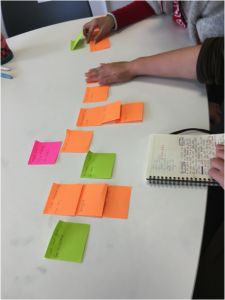Most teachers will at some point have used Post-Its in their classroom. Whether they’re used for a game of Who am I?, to review vocabulary or as a classroom management technique, these versatile office staples are a favourite with a good few of my colleagues. I think this is my new favourite use for them.
Inspired by my previous post ‘Teaching Narrative Tenses: that Time I would have Killed for Cuisenaire Rods’, when reviewing narrative tenses with the same group, I also decided to recycle and refine the student-created timeline using the humble Post-It. As I said in the same previous post, the story told in Speak Out Intermediate wasn’t particularly accessible to my students, so this time I decided to use a video that would clearly illustrate the events. This helped the students to have a clearer idea of the sequence of events, they were also able to refer back to it to help in creating the timeline. For this, I used the augmented reality app Aurasm.
Here’s a rough outline of the lesson up until Post-It timelines:
- Students given screenshots from the video. In pairs, arrange and tell story.
- Watch video. Tell story.
- Dictagloss of my version of the story. This ended up being changed to a slower read through while students took notes and retold the story orally. They picked up on the TL from their own stories.
- Students given printed copy of story to read.
- Language focus.students identify tenses from the text.
Post-It Timelines
- Students given Post-Its with verbs from the story. I made sure these were colour-coded to help students to identify the tenses/for clearer visual effect.
- In pairs, referring to video and written story, students arrange the Post-Its into a timeline. T can offer extra guidance/ask questions to focus students’ attention during this activity.
- Students had to then explain their choices and how the actions linked together. Some specific questions were needed at this point. The intention had been for students to look at each other’s timelines, but this wasn’t possible as the pairs finished creating the timelines at different stages. Since the idea was to help the students to understand the TL more, I wasn’t afraid to let this overrun, and the next task is flexible enough to allow for this eventuality.
- Following this, each pair had to tell/write the story for another different video. Students had to complete this for the following lesson.
The next lesson
In the following lesson, the class reviewed the TL by retelling the story and highlighting the links by recreating the timeline.
Pairs then revised the writing they had prepared for homework, and wrote their own PostIts with the verbs from their story. They then gave the story and PostIts to the other pair who was able to successfully create a timeline, identifying the order of the actions and links between them. Students then checked the story (and use of TL) using the videos.
The follow up, homework was for SS to write a story about a time they worked in a team using the TL. Students showed a much better understanding of the TL than from the first lesson on narrative tenses and reported that they felt more confident in using the language thanks to the Post-It Timelines technique (I didn’t even have to pay them!).




I really like this Rachel. I love post-its for their no ability and I’ve used them with BE clients – getting them to explain company structure and plan presentations – but I especially like how you’ve utilised them for language awareness. The colour-tense element is so simple but I imagine very effective.
Just an aside: I’m curious to know whether you chose the colour coding (and if so, what were the reasons for your choices?) or whether the learners did…?
JB x
Thinking about it, I’ve used them for similar things in Business classes too. I love how flexible a material they are.
I have to admit that the colour choices in the first set of Post-Its I made had more to do with how large a block of each colour I had left than anything else. I’m not sure how the students chose their colour-coding – I’ll have to ask next time. What colours would you use for each tense?
Good question…
Past simple is green
Past progressive is blue
Past perfect is yellow
? 🙂
You?
Hmmm…past progressive is green. Past simple is orange. Past perfect is yellow (like faded/old orange – would fit here I guess!).